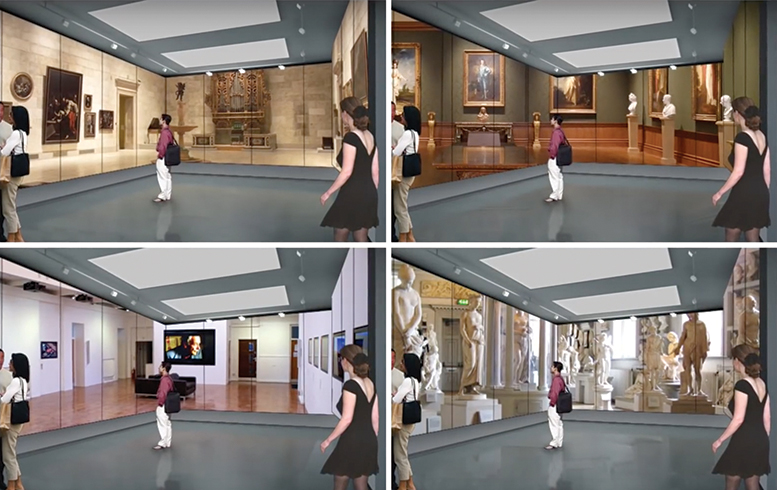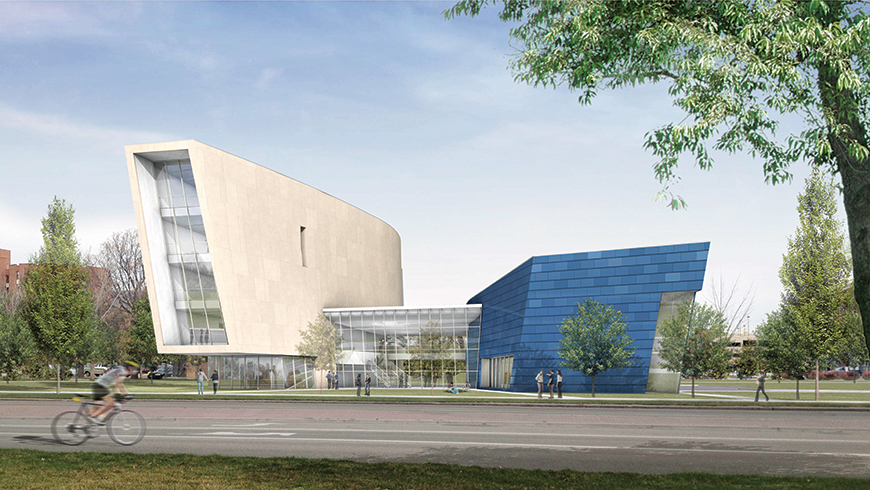In early planning meetings for what he calls his “crowning achievement,” Boise State University President Bob Kustra’s mantra was “think Guggenheim.”
Most important, he said, was that Boise State’s new $45 million Center for Fine Arts (CFA) boldly stand out from other buildings on campus.
“We wanted to make sure it was an architectural icon of which we can be proud for years to come,” said Kustra, who retired earlier this year. “So it could forever demonstrate Boise State’s commitment to the arts and humanities.”
The CFA’s prominent location on Capitol Boulevard between the Morrison Center for the Performing Arts and the Micron Business and Economics Building serves as a gateway into Boise’s cultural corridor. The Boise Art Museum, library and Log Cabin literary center are just a few of the arts amenities just steps away.
While not financially or structurally on par with the Guggenheim in Bilbao, Spain, it might easily be the latter’s spirit animal. The Guggenheim sits on a river in the heart of Spain’s Basque country, while the Center for Fine Arts is steps from the Boise River and Boise’s Basque block.
Set to open in fall 2019, the modern concrete and glass building was designed by Boise’s LCA Architects, who partnered with HGA in Minneapolis.
The CFA will bring together Boise State’s 3,000 art students in new classrooms, studios, and workspaces, located in a five-story tower on the building’s north side. Previously, the department was scattered across seven inadequate and sometimes unsafe buildings. “We were on a provisional accreditation because of those buildings,” Kustra said. “It was imperative to find a way to improve the spaces we had for our art department.”
Bringing together painting, sculpture, metal arts and other art disciplines under one roof will allow students to collaborate and learn in ways not previously possible, said Dan Scott, interim chair of Boise State’s art department. “This building will go a long way to remove limitations. That’s huge,” he said. The CFA also will enhance recruiting for students and faculty, and be a draw for the university’s visiting artist program, Scott said.
And while a boon to faculty and students, Kustra, who describes himself as a devotee of the arts, is most excited about the building’s potential for the community. “I don’t expect the community to get all excited over a space for faculty or students to study art, so we wanted to create something in the Center for Fine Arts that serves the community,” he said.
He consulted the College of Innovation and Design, collaborating with Anthony Ellertson, director of the Gaming, Interactive Media and Mobile Technology (GIMM) program, and his students. The result is the virtual World Museum, which will reside in the glass middle portion of the building.

The virtual World Museum at the new Center for Fine Arts. Illustration by LCA and HGA Architects.
“It will be a high-tech, high-touch museum that will (digitally) bring in museum pieces and artwork from around the world,” Kustra said.
Museum visitors will find several video screens that employ “wave technology,” which means when you’re done viewing a painting or sculpture, you wave your hand to move on to the next piece. There will also be some version of virtual and augmented technologies requiring patrons to wear headsets.
“You can walk around (Michelangelo’s) statue of David, for example, without going all the way to Florence,” Kustra said. Or perhaps a famous painting will have an augmented experience that takes a viewer deeper into the artist’s life by showing his or her birthplace, home, or technique.
Kustra said he’s most excited by the opportunities it will create for school kids who’ve yet to develop an appreciation for the role art has played in civilization.
“I want to see these kids have the opportunity to walk into this room where they can literally go on a worldwide trip to some of the finest art museums and see works they may never see in a lifetime,” he said.
Kustra’s enthusiasm for the World Museum is shared by community donors, who’ve pledged $5 million to the building. The state also chipped in $5 million, and the rest of the funding has come from bonding through the university.
Fonda Portales, Boise State art collections manager and World Museum curator, said she’s spent the last two years looking at other institutions and thinking about the ways the visual arts can be seen in interactive, dynamic, augmented spaces.
She cited Villanova University’s 10-feet-by-13-feet “cave space,” in which viewers can see a 360-degree capture of the Sistine Chapel.
In June, Portales and faculty and students from Computer Science and GIMM traveled to San Francisco and Los Angeles to digitally capture art and text, including a Diego Rivera mural and artifacts and scholarly texts on Mesoamerica.
She said the World Museum would be a boon for students who may, for example, work an entire summer on a virtual reality project.
The museum will allow visitors to decide what type of experience they want to have in the museum’s cave space, which will be about 940 square feet. The next goal will be to have students travel internationally to digitally capture works and build relationships with other museums.
Of course, their work isn’t cheap, and as cutbacks in the arts become more common, community support has been vital, Kustra said. “I thought one of our significant challenges would be to show American higher education that, in this day and age, it’s still possible for a community to come together and support the arts and humanities,” he said. “I can’t wait for the fall of 2019.”

